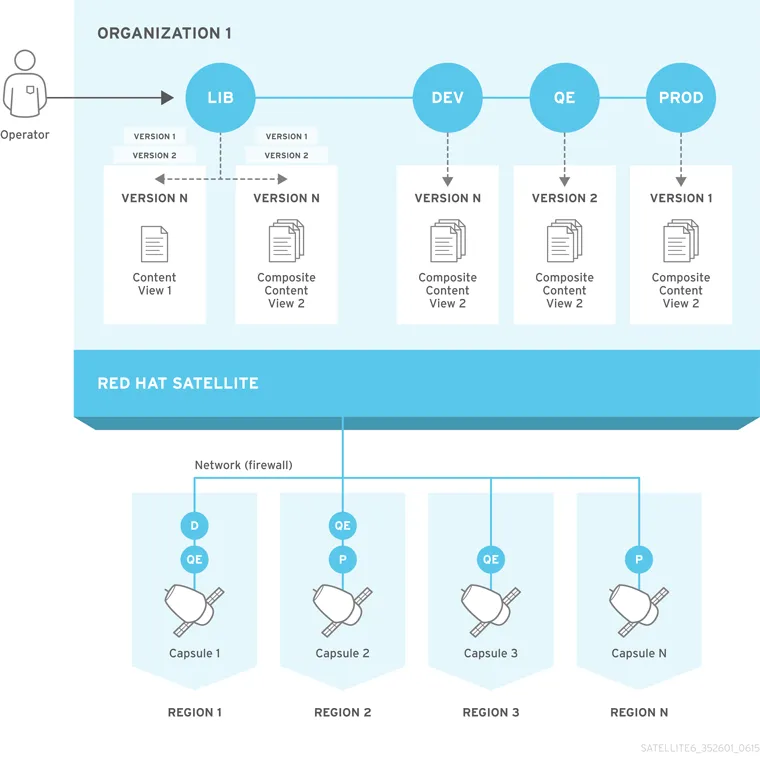Red Hat Satellite is a systems management solution that can help an organization deploy, configure and maintain systems across multi-cloud environments and on-premises environments. Satellite provisions, monitors and remotely manages Red Hat Enterprise Linux deployments in a single centralized tool.
JFrog Artifactory is a universal repository manager for binary life cycle management of artifacts, providing end-to-end management of artifacts throughout the software lifecycle process.
The purpose of this post is to show how Artifactory’s repository management helps organize and distribute Satellite’s life cycle management capabilities to downstream layers to keep Enterprise Linux systems running with consistent packages across the enterprise.
In Satellite, one could define a library of content from external sources for an Organization. Content views can be created as subsets of content from the Library. One can publish and promote content views into lifecycle environments - typically dev, QA and Production.
 In Artifactory, we need to define remote repositories mapping to each lifecycle environment. For example: Define an Artifactory remote repository called “dev-rpm-remote-dc” which corresponds to the dev lifecycle environment.
In Artifactory, we need to define remote repositories mapping to each lifecycle environment. For example: Define an Artifactory remote repository called “dev-rpm-remote-dc” which corresponds to the dev lifecycle environment.
Steps to combine Red Hat Satellite and JFrog Artifactory
Let's walk through the steps you need to follow to set this up. The post assumes you already have an up-to-date version of Red Hat Satellite and JFrog Artifactory. (The post is based around JFrog’s Artifactory version 7.21.)
Create an Organization Debug Certificate
To create a debug certificate for an organization, complete the following steps:
1. In the Satellite web UI, navigate to Administer > Organizations

2. Select an organization that you want to generate a debug certificate for
3. Click Generate and Download

4. Save the certificate file in a secure location
Gather the Satellite URL for the lifecycle environment you wish to add:
Procedure
Log into a system that is registered to the Satellite server and connected to the Lifecycle Environment you wish to add to Artifactory, and either manually assemble the URL or use the script below to retrieve the URLs.
Manual method:
1. Start with the URLs listed in /etc/yum.repos.d/redhat.repos
2. Replace $releasever with the value of: rpm -q --provides rpm -qf /etc/redhat-release | grep releasever
3. Replace $basearch with the value of: uname -i
Script:
You can run this script to automatically generate URLs for your lifecycle environment:
curl -s https://raw.githubusercontent.com/cshabazian/Get-Satellite-URLs/main/Get_Satellite_URLs.sh | bash
Add the Satellite Certificate to Artifactory:
Procedure
1. In the Artifactory web UI, navigate to SERVICES > Artifactory and select Certificates

2. Click + New Certificate

3. Give this certificate a recognizable alias such as Organization Satellite Certificate and drag and drop the certificate generated above into the Certificate box and click Save

Restart Artifactory server process for certificates to be trusted:
Procedure
1. Login to the Artifactory server and run as root:
systemctl restart artifactory
Add the repository to Artifactory:
Procedure
1. In the Artifactory web UI, navigate to Repositories > Repositories, click + Add Repositories, and select Remote Repository

2. In the Package Type dialog that pops up, select RPM

3. Select Advanced options and in SSL / TLS Certificate, select the certificate you loaded in the previous steps

4. Select Basic options, and in the URL box, paste the URL you previously gathered and click Test to ensure everything is setup correctly, Then click Save & Finish

Conclusion
In this post we’ve demonstrated how to define repositories in Artifactory as a backend to Satellite package distributions. We hope you’ll be able to take these basic steps and leverage them to do your own integrations between JFrog’s Artifactory version 7.21 and Red Hat Satellite version 6.x.
If you have questions about our proposed integration, or if you’re just getting started on your Red Hat and JFrog journey, find out more at JFrog.com or try Artifactory out for yourself on OpenShift.
Special thanks to Chip Shabazian, Red Hat Senior Platform Technical Account Manager, who made a major contribution to the writing of and technical review of this post, and the work to bring these products together to solve customer problems.
저자 소개
Sudhindra Rao is seasoned technologist helping customers enabling them to transform how they build, deploy and run software. He has worked on a complete spectrum of technologies from mainframe to middleware to cloud and now DevOps. Rao is a leading Indian classical musician teaching Indian Percussion drum called Mridangam and lives in Raleigh, NC.
유사한 검색 결과
Red Hat to distribute NVIDIA CUDA across Red Hat AI, RHEL and OpenShift
Introducing Red Hat’s STIG-hardened UBI for NVIDIA GPUs on Red Hat OpenShift
Rethinking Networks in Telecommunications | Code Comments
Transforming Your Priorities | Code Comments
채널별 검색
오토메이션
기술, 팀, 인프라를 위한 IT 자동화 최신 동향
인공지능
고객이 어디서나 AI 워크로드를 실행할 수 있도록 지원하는 플랫폼 업데이트
오픈 하이브리드 클라우드
하이브리드 클라우드로 더욱 유연한 미래를 구축하는 방법을 알아보세요
보안
환경과 기술 전반에 걸쳐 리스크를 감소하는 방법에 대한 최신 정보
엣지 컴퓨팅
엣지에서의 운영을 단순화하는 플랫폼 업데이트
인프라
세계적으로 인정받은 기업용 Linux 플랫폼에 대한 최신 정보
애플리케이션
복잡한 애플리케이션에 대한 솔루션 더 보기
가상화
온프레미스와 클라우드 환경에서 워크로드를 유연하게 운영하기 위한 엔터프라이즈 가상화의 미래
